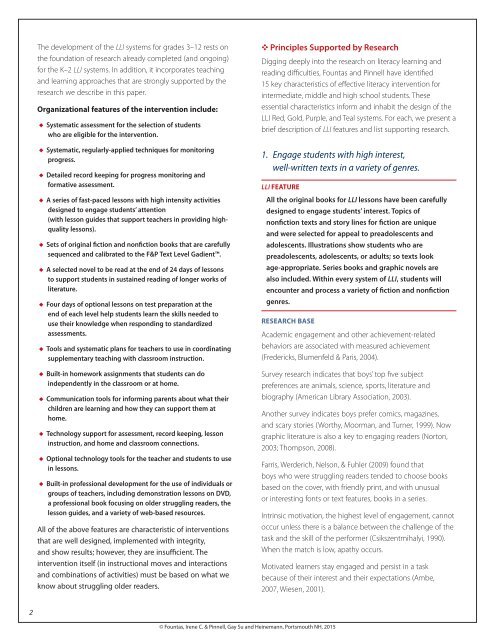Leveled Literacy Intervention
LLI_3_8_ResearchBase
LLI_3_8_ResearchBase
You also want an ePaper? Increase the reach of your titles
YUMPU automatically turns print PDFs into web optimized ePapers that Google loves.
The development of the LLI systems for grades 3–12 rests on<br />
the foundation of research already completed (and ongoing)<br />
for the K–2 LLI systems. In addition, it incorporates teaching<br />
and learning approaches that are strongly supported by the<br />
research we describe in this paper.<br />
Organizational features of the intervention include:<br />
XX<br />
Systematic assessment for the selection of students<br />
who are eligible for the intervention.<br />
XX<br />
Systematic, regularly-applied techniques for monitoring<br />
progress.<br />
XX<br />
Detailed record keeping for progress monitoring and<br />
formative assessment.<br />
XX<br />
A series of fast-paced lessons with high intensity activities<br />
designed to engage students’ attention<br />
(with lesson guides that support teachers in providing highquality<br />
lessons).<br />
XX<br />
Sets of original fiction and nonfiction books that are carefully<br />
sequenced and calibrated to the F&P Text Level Gadient.<br />
XX<br />
A selected novel to be read at the end of 24 days of lessons<br />
to support students in sustained reading of longer works of<br />
literature.<br />
XX<br />
Four days of optional lessons on test preparation at the<br />
end of each level help students learn the skills needed to<br />
use their knowledge when responding to standardized<br />
assessments.<br />
XX<br />
Tools and systematic plans for teachers to use in coordinating<br />
supplementary teaching with classroom instruction.<br />
XX<br />
Built-in homework assignments that students can do<br />
independently in the classroom or at home.<br />
XX<br />
Communication tools for informing parents about what their<br />
children are learning and how they can support them at<br />
home.<br />
XX<br />
Technology support for assessment, record keeping, lesson<br />
instruction, and home and classroom connections.<br />
XX<br />
Optional technology tools for the teacher and students to use<br />
in lessons.<br />
XX<br />
Built-in professional development for the use of individuals or<br />
groups of teachers, including demonstration lessons on DVD,<br />
a professional book focusing on older struggling readers, the<br />
lesson guides, and a variety of web-based resources.<br />
All of the above features are characteristic of interventions<br />
that are well designed, implemented with integrity,<br />
and show results; however, they are insufficient. The<br />
intervention itself (in instructional moves and interactions<br />
and combinations of activities) must be based on what we<br />
know about struggling older readers.<br />
YYPrinciples Supported by Research<br />
Digging deeply into the research on literacy learning and<br />
reading difficulties, Fountas and Pinnell have identified<br />
15 key characteristics of effective literacy intervention for<br />
intermediate, middle and high school students. These<br />
essential characteristics inform and inhabit the design of the<br />
LLI Red, Gold, Purple, and Teal systems. For each, we present a<br />
brief description of LLI features and list supporting research.<br />
1. Engage students with high interest,<br />
well-written texts in a variety of genres.<br />
LLI FEATURE<br />
All the original books for LLI lessons have been carefully<br />
designed to engage students’ interest. Topics of<br />
nonfiction texts and story lines for fiction are unique<br />
and were selected for appeal to preadolescents and<br />
adolescents. Illustrations show students who are<br />
preadolescents, adolescents, or adults; so texts look<br />
age-appropriate. Series books and graphic novels are<br />
also included. Within every system of LLI, students will<br />
encounter and process a variety of fiction and nonfiction<br />
genres.<br />
RESEARCH BASE<br />
Academic engagement and other achievement-related<br />
behaviors are associated with measured achievement<br />
(Fredericks, Blumenfeld & Paris, 2004).<br />
Survey research indicates that boys’ top five subject<br />
preferences are animals, science, sports, literature and<br />
biography (American Library Association, 2003).<br />
Another survey indicates boys prefer comics, magazines,<br />
and scary stories (Worthy, Moorman, and Turner, 1999). Now<br />
graphic literature is also a key to engaging readers (Norton,<br />
2003; Thompson, 2008).<br />
Farris, Werderich, Nelson, & Fuhler (2009) found that<br />
boys who were struggling readers tended to choose books<br />
based on the cover, with friendly print, and with unusual<br />
or interesting fonts or text features, books in a series.<br />
Intrinsic motivation, the highest level of engagement, cannot<br />
occur unless there is a balance between the challenge of the<br />
task and the skill of the performer (Csikszentmihalyi, 1990).<br />
When the match is low, apathy occurs.<br />
Motivated learners stay engaged and persist in a task<br />
because of their interest and their expectations (Ambe,<br />
2007, Wiesen, 2001).<br />
2<br />
© Fountas, Irene C. & Pinnell, Gay Su and Heinemann, Portsmouth NH, 2015


